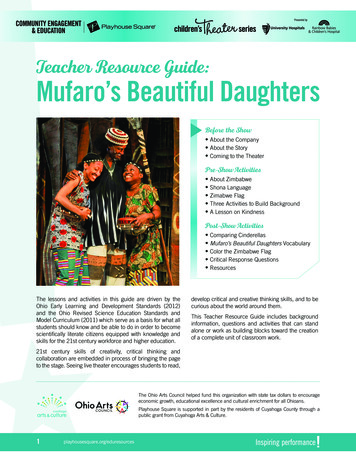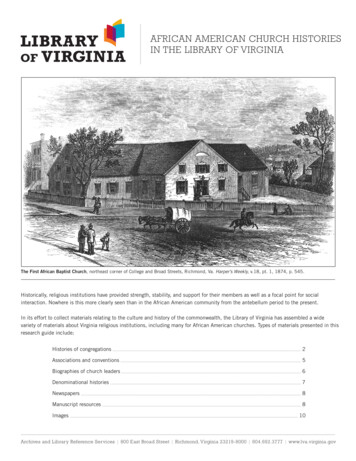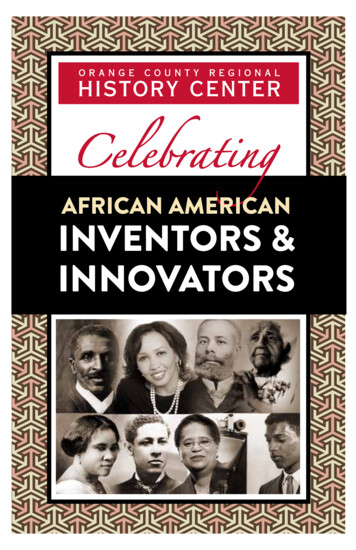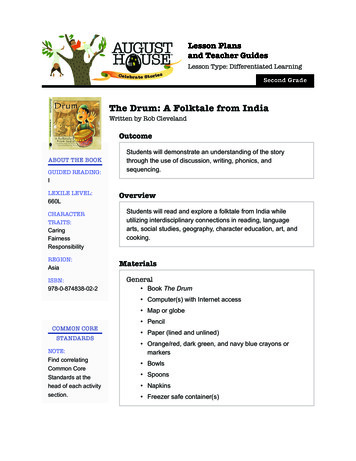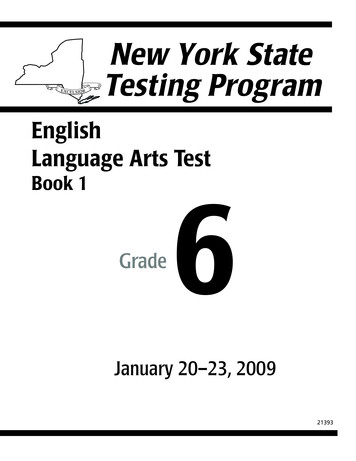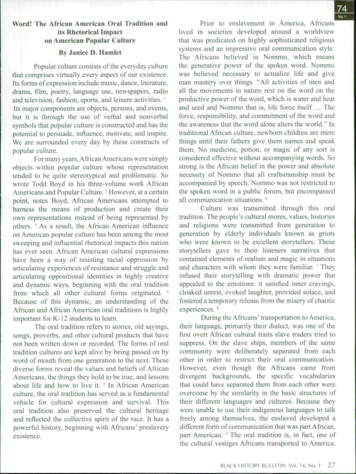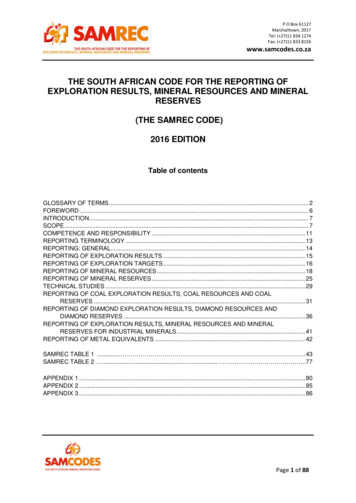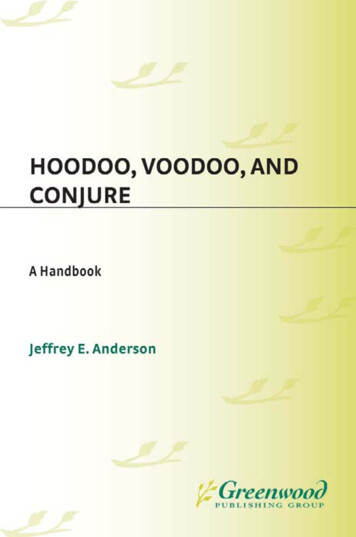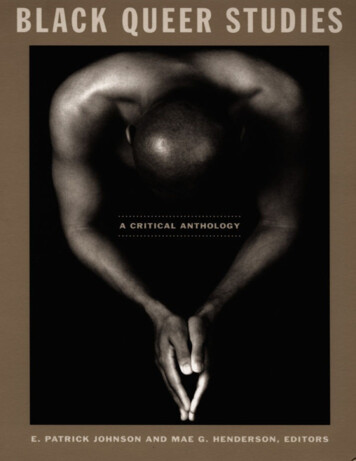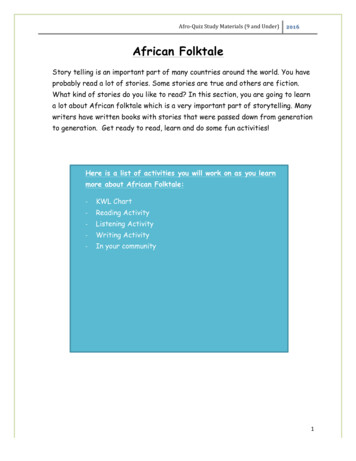
Transcription
Afro- ‐QuizStudyMaterials(9andUnder)!"# African FolktaleStory telling is an important part of many countries around the world. You haveprobably read a lot of stories. Some stories are true and others are fiction.What kind of stories do you like to read? In this section, you are going to learna lot about African folktale which is a very important part of storytelling. Manywriters have written books with stories that were passed down from generationto generation. Get ready to read, learn and do some fun activities!Here is a list of activities you will work on as you learnmore about African Folktale:- ‐KWL Chart- ‐Reading Activity- ‐Listening Activity- ‐Writing Activity- ‐In your community1
Afro- ‐QuizStudyMaterials(9andUnder)!"# Look at the KWL Chart below. Think about what you already know about AfricanFolktale. Write it down in the “K” column. What do you want to know about AfricanFolktale? Write it down in the “W” column.KWL CHARTKWhat I know aboutAfrican folktaleWWhat I want to knowabout African folktaleLWhat I learned aboutAfrican folktale2
Afro- ‐QuizStudyMaterials(9andUnder)!"# READING ACTIVITYHave you heard about Cinderella, Beauty and the Beast, the Princess and the Frog?You have probably read the stories or watched the movies! How about Anansi thespider? Kalulu the hare? Gudo the baboon? If not, then you are in for a greatadventure. Welcome to the world of African folktales!For centuries, Africans and their descendants have been telling stories aboutfaraway lands and places. The stories always have animals that can talk. What isfascinating about these stories is that they have travelled from Africa to manyparts of the world where Africans and descendants of Africans now live. Thestories may have changed slightly but the characters and the messages and theway the stories are told is still the same.People whose ancestors came from Africa now live in countries such as Canada, theUnited States, Jamaica, Trinidad and Tobago, Brazil, England, Portugal and manymore.Whatis special about these folktales?1. the stories are told orally and the people listening have to sing songs2. the stories always include animals and nature3. the stories teach a lesson about life4. the stories do not always have a “happily ever after” endingHave you ever participated in such story telling?You are now going to read about a famous character in African Folktale: Anansi,the spider! Anansi is a spider that talks, walks, eats and behaves just like peopledo!3
Afro- ‐QuizStudyMaterials(9andUnder)!"# Anansi the SpiderWho is Anansi?Anansi is a character who often takes the shape of a spider and is considered tobe the spirit of all knowledge of stories. Even though he is a spider, he often actsand appears as a man in the stories. He is also one of the most importantcharacters of West African and Caribbean Folklore.The Anansi tales started in present-day Ghana and were first told by the Ashantipeople. The word Ananse means "spider" in the Akan language. The stories laterspread to other groups of the Akan and then to the West Indies, Suriname, andthe Netherlands Antilles.Below are other names for Anansi in different countries around the world: Bru Nansi (Virgin Islands)Annancy or Anancy (Jamaica, Grenada, Costa Rica, Colombia, Nicaragua)Anansi (Trinidad and Tobago)Anansi Drew (The Bahamas)Aunt Nancy (South Carolina)Cha Nanzi (Aruba)Kompa Nanzi (Curaçao, Bonaire)Kwaku Anansi (Akanland)Ba Anansi (Suriname)His wife is known as Shi MariaActivity:We already know that Anansi the Spider is originally from West Africa but he isalso found in folktales in the USA and the Caribbean. Below is a map of the world.Can you find, label and color West Africa, North America, and the Caribbean, thethree regions where people tell the story of Anansi?4
Afro- ‐QuizStudyMaterials(9andUnder)!"# What does Anansi look like?Anansi is shown in many different ways. Sometimes he looks like an ordinary spider,sometimes he is a spider wearing clothes or with a human face and sometimes helooks much more like a human with spider elements, such as eight legs.Activity:Here are some images of Anansi the Spider. What are some of the differences andwhat things are the same in all three pictures? Write them down.5
Afro- ‐QuizStudyMaterials(9andUnder)!"# Watch an Anansi short animation!Do you know about the National Film Board of Canada? They make a lot of reallycool short films and documentaries about things that matter to differentCanadians and the different cultures they all come from. They even made a shortfilm about Anansi as part of its Talespinners Collection. This is a collection offolktales from all over the world. Go online and copy this link to watch The Magicof Anansi: https://www.nfb.ca/film/magic of anansiWhat do you think about Anansi? Can you write a short summary of what youwatched? Use the space below to write your summary.6
Afro- ‐QuizStudyMaterials(9andUnder)!"# Read about AnansiHere are some stories about Anansi the spider that can be found at the EdmontonPublic Library. Borrow one book and read it for yourself!1. Anansi Goes Fishing2. Anansi and the Talking Melon3. Anansi’s Party Time4. Anansi and the Moss Covered RockWRITING ACTIVITY: LET’S PLAY A GAME!By now you will have read a story about Anansi the Spider. Here is a word puzzlefrom a story you can find online at the Edmonton Public Library called Anansi andthe Moss Covered Rock. See if you can find all the words at the bottom!7
Afro- ‐QuizStudyMaterials(9andUnder)!"# 8
Afro- ‐QuizStudyMaterials(9andUnder)!"# LISTENING ACTIVITYListen to an elder tell a story. (Get a story teller to tell a story that includesanimals, songs, and audience participation)Here is an example of a folktale from Senegal that you can watch on YouTube.https://www.youtube.com/watch?feature player detailpage&v TeNw0hOh0hk-Who are the main characters in the story?-What do you think is the moral of this story?-What did you like about the way the story was told?IN THE COMMUNITYComplete the table below by finding out information from the library, from yourparents or elders in the community. Some book suggestions are given at the end ofthe table *suggestion is to provide actual titles and fill in some of the squares*.You can also google. The first one has been done for you as an example.AnimalStory titleCharacteristics ofthe animalBaboonBaboon wants awifeNot very cleverLesson Ilearned fromthis storySpiderHareLionElephantTortoiseCrocodile9
Afro- ‐QuizStudyMaterials(9andUnder)!"# Complete the L portion of the KWL chart. What did you learn about Africanfolktale?Summary:Folktales are one of the ways that history is passed down the generations inAfrican, Caribbean, African American and African Canadian communities. In fact,thanks to folktale characters like Anansi the Spider, we can see that the culturesin these parts of the world we have studied in this chapter are all closely related.Folktales are a fun way for us to learn lessons or morals that can help us every day.Lastly, folktales are great for bringing together all kinds of people in ourcommunity, young and old.Thinking Question - why is African folktale important?10
Afro- ‐QuizStudyMaterials(9andUnder)!"# REFERENCES11
Afro- ‐QuizStudyMaterials(9andUnder)!"# The Underground RailroadHave you heard or read about the Underground Railway? Do you know what arailroad looks like right? If you don’t, here is a picture. You might know thisas a train track. The LRT here in Edmonton moves on a train track or a railroad.Today the train tracks on the Edmonton LRT lead to Clairview and to Century Park.There are many stops along the track and people get off at different stops.In this module you are going to learn about the Underground Railroad. It played avery important part in the history of the United States and Canada. Canada wasthe destination that many people hoped to get to. Many books have been writtenabout the Underground Railroad and the people who worked on the UndergroundRailroad.Here is a list of activities you will work on as you learn about TheUnderground Railroad:- ‐KWL Chart- ‐Reading activity- ‐Listening activity- ‐In the community1
Afro- ‐QuizStudyMaterials(9andUnder)!"# KWL CHARTLet’s start by completing the KWL chart below. Think about what you know aboutthe Underground Railroad or what you think you know. It’s ok if you have neverheard of it and you do not know anything. Then think about what you want to knowabout the Underground Railroad.KWhat I know about theUnderground RailroadWWhat I want to knowabout the UndergroundRailroadLWhat I learned about theUnderground Railroad2
Afro- ‐QuizStudyMaterials(9andUnder)!"# READING ACTIVITYSomeimportantwords.Many people have written stories about the UndergroundRailroad. It was not really a rail road with train tracksgoing underground. It was a series of places and peopleConductors–thepeoplewho helped slaves escape from slavery in the UnitedStates in the 1800s.The Underground Railroad was a group of people whoworked together to help slaves run away from - states to free states and to Canada. People like HarrietStationmasters- ‐theTubman, Frederick Douglass, and Levi Coffin played y important role in helping slaves escape from slaveryin the Southern United States to come to the NorthernStates where they could be free. The slaves who wererunning away from slavery had to make long and dangerousjourneys to get to freedom. They had to be careful not to get caught trying toescape. They had to rely on help from other people along the way especially inplaces they did not know. The Underground Railroad did not stop in the Northernstates of the USA. It went even further north to Canada.The people who helped slaves escape to freedom using the Underground Railwayused their own special words to help. For example, people who guided the runawayslaves from one place to the next were called conductors. The places whererunaway slaves could find food or could sleep during the night were called stationsor safe houses. The people who hid slaves in their homes, in churches, or in theirbarns were called station masters.Many slaves running away wanted to get to Canada. There were other destinationsthat slaves running away went to. Some of them ended up in Mexico, the CaribbeanIslands, South America, and cities in the North United States.3
Afro- ‐QuizStudyMaterials(9andUnder)!"# Who were the key people involved in the Underground Railroad?Many stories have been written about the people who were involved in theUnderground Railroad. The tables below contain some information on some of thesefamous people.Table 1- Harriet Tubman She was born in 1820 in Dorchester County,Maryland.Harriet Tubman was a slave whoescaped in 1849.Known as “Moses”, she was aconductor. She was also known as“Minty”.She is one of the most importantfigures involved in theUnderground Railroad.She made 19 trips to theSouthern plantations of theUnited States.These 19 trips resulted in herleading around 300 slave tofreedom.To the right and below are some titlesof books written about Harriet Tubmanand her story.4
Afro- ‐QuizStudyMaterials(9andUnder)!"# Table 2- Levi Coffin and John FairfieldLevi Coffin John Fairfield He was born in 1798 in New Lawn,North Carolina.He is sometimes called the“President of the UndergroundRailroad”.His home was a station or safehouse. It was known as “GrandCentral Station”.The station helped almost 3000slaves on their journey tofreedom.Coffin later became a businessman and sold only goods made withfree labour.John was born in 1797 in Saco,York County, Maine.Even though he was raised in afamily that had slaves, Fairfieldbecame a conductor in theUnderground Railroad.He would pretend to be a slaveholder or a slave trader in orderto help runaway slaves escape tofreedom.5
Afro- ‐QuizStudyMaterials(9andUnder)!"# Table 3- Frederick Douglass Mr. Frederick Douglass was born inTuckahoe, Maryland in 1818. He is an ex-slave who escaped tothe Northern United States as ayoung man.He became an activist and leaderof the Underground Railroad inNew York.Douglass wrote autobiographies(stories about himself) of his timeas a slave and as a free man. Heset a great example and gave hopeto many.Frederick fought for civil rightsand equality of all humans.To the right and below are some titlesof books written about FrederickDouglass.6
Afro- ‐QuizStudyMaterials(9andUnder)!"# And in Canada Reverend Josiah Henson played a very important role inthe Underground Railroad in Canada.Josiah Henson was born in the United States and heworked there as a slave for 41 years. He managed toescape to Canada in 1830 using the Underground Railroad.When he got to Canada he built a settlement and a schoolfor other slaves who had run away and come to Canada.Reverend Josiah Henson wrote an autobiography, a bookabout his life, in 1849. Another famous book that usessome information about his life called “Uncle Tom’s Cabin”,was written by Harriet Beecher Stowe. Today you can visit Uncle Tom’s CabinHistoric Site in Dresden, Ontario.Here are some book cover images of “Uncle Tom’s Cabin”. See if you can find thesein your local 46787.jpg7
Afro- ‐QuizStudyMaterials(9andUnder)!"# LISTENING ACTIVITYWatch a video about the Underground Railway. The video is of Henry Cole readinghis picture book called “Unspoken: A story from the Underground Railroad”. Onthe internet you can search for “Henry Cole and Unspoken” to find the video. Oryou can follow this link https://www.youtube.com/watch?v voL dToHjUUQuestion:What happened in this story?IN THE COMMUNITYGo to your local library and look up a book on the Underground Railway. Ask thelibrarian to help you find one. Find out information that can help you answer thefollowing question:1. Why is the Underground Railway famous?What have you learned about the Underground Railroad? Complete the lastcolumn of the KWL chart on page 2.8
Afro- ‐QuizStudyMaterials(9andUnder)!"# REFERENCES1. https://en.wikipedia.org/wiki/Harriet Tubman2. railroad-facts.html3. field.html4. ?index F0000065. https://en.wikipedia.org/wiki/Frederick Douglass6. https://en.wikipedia.org/wiki/Josiah Henson7. 14308. -92783249
Afro- ‐QuizStudyMaterials(9andUnder)!"# Featured Author: Tololwa M. MollelWe are lucky to be part of a community that is full of talented people who wecan learn from. People in your community such as elders and storytellers canteach you interesting things that you might not find in a book! In this module weare going to learn more about Tololwa Mollel, a story-teller and writer who liveshere in Edmonton. Have you heard about Mr. Mollel before? Do you know whattypes of books he writes?Here is a list of activities you will work on as you learn about TololwaMollel:- ‐KWL Chart- ‐Reading text and reading comprehension questions- ‐Listening and listening comprehension questions- ‐In the community- ‐Writing – word puzzle, completing KWL chart- ‐Trivia – maps (showing geographical location and fun facts)1
Afro- ‐QuizStudyMaterials(9andUnder)!"# KWL CHARTLook at the KWL Chart below. Think about what you already know about TololwaMollel. Write it down in the “K” column. What do you want to know about him?Write it down in the “W” column.KWhat I know aboutTololwa MollelWWhat I want to knowabout Tololwa MollelLWhat I learned aboutTololwa Mollel2
Afro- ‐QuizStudyMaterials(9andUnder)!"# READING ACTIVITYIn many African and Caribbean traditions, storytellers play an important part inthe life of the community. They tell stories that entertain both children andadults, but they also have a special job that they do through their stories. Haveyou ever thought about why story-tellers are important? Thanks to the storiesthat they tell, we can learn about the way people lived long ago, or about culturesfar away from us. They help the community toremember interesting and important thingslong after they have happened. And, often,their stories have an important lesson ormoral for us to learn. The lesson or moral canhelp us to be better friends and family toeach other.To the left is a picture of Tololwa Mollel.Tololwa Mollel was born in Arusha, Tanzania, Africa. He is a storyteller whowrites story books for children. He also writes plays. Mollel has writtenseventeen books that have been published internationally (in many differentcountries). He has also won many awards. Some of his award winning story booksare in the table below.1. Rhinos for Lunch and Elephantsfor Supper3
Afro- ‐QuizStudyMaterials(9andUnder)!"# 2. Big Boy3. My Rows and Piles of CoinsTololwa Mollel’s books have been published in Canada, the Unites States,Australia, England, and Tanzania. Mr. Mollel’s books have been translated intomany different languages. Some examples of these languages are: Kiswahili – Tanzania’s national language Korean Norwegian South African languages SpanishMollel lives here, in Edmonton, Alberta, Canada with his wife and two kids. Beforehe moved to Canada, he lived in Tanzania where he taught at a university. He was“I aim to provide a feast of words – writtenand spoken – for the eye, the ear and themind; as well as for the creative imagination,and for performance.”TololwaM.Mollelalso an actor andperformer. As an actorand performer, hetraveled to countries likeGermany and Sweden.Now, Mollel writeschildren’s books and is apart of a number of4
Afro- ‐QuizStudyMaterials(9andUnder)!"# organizations that work with writers. In addition to writing books, Mollel givesworkshops to children in schools. He also gives presentations and reads stories atlocal libraries.MAPS AND TRIVIAThis is a map of the continent of Africa. Your task is to find Tanzania, thecountry in which Tololwa Mollel was born and color it in. (hint: Tanzania is in theEast of the continent, that’s the right hand side of the map!)A little bit of trivia and fun facts about Tanzania for you to remember: The capital city of Tanzania is Dodoma. The largest city is Dar Es Salaam. Dar Es Salaam is Arabic for “House of Peace”. Tanzania has two official languages: Swahili and English.5
Afro- ‐QuizStudyMaterials(9andUnder)!"# LISTENING ACTIVITYIn this section we are going to listen to Tololwa Mollel tell a story. After thisthere are a few questions for you to answer about the story:Click on this link to watch a video of Tololwa Mollel telling the story called Justthe Perfect Thing: https://www.youtube.com/watch?v wFYA 0HoKS0Now try to answer the following questions. Listen to the story again if you needto!1. This story is about Ngwele who is a maker-of-things. What kind of animalis Ngwele?2. Who did the hare trick first?3. Who did the hare take spots from?4. How did the hare get a scale-made coat?5. What did the hare make with the birds’ feathers?6. What happened to hare in the end?7. What do you think the lesson or the moral of the story is?IN THE COMMUNITYGo to your local Edmonton Public Library and check out one or more of TololwaMollel’s books. A list of some of his books is in the table below.How many books can you read before Afro Quiz?Complete the table by writing down the names of the main characters in thestories you have read. Put a check markü next to each book title once you finishreading it. You can also listen to someone reading the story to you! The first onehas been done for you as an exampleBook Title / Story TitleMain characters in thestoryI haveread/listenedto the story ü 6
Afro- ‐QuizStudyMaterials(9andUnder)!"# The Orphan BoyA Promise to the SunThe Princess Who Lost Her HairThe King and The TortoiseKele’s SecretDume’s RoarKitoto The MightySubira SubiraCharacter names hereü WRITING ACTIVITY: Let’s play a game!Have you noticed that there are animals in many of Tololwa Mollel’s stories?Animals are a big part of storytelling in Africa.Below is a word puzzle for you to complete. All the words you have to find areanimals that can be found in different parts of Africa. Can you find all thewords?If you have never heard of the animal before, ask somebody to help you find apicture of it on the internet!7
Afro- ‐QuizStudyMaterials(9andUnder)!"# CHPANGOLINRHINOCEROSSPRINGBOKZEBRA8
Afro- ‐QuizStudyMaterials(9andUnder)!"# Completing the KWL Chart (Writing Activity)We have read about Tololwa Mollel’s life, listened to a story of his and by now wehave also checked out at least one of his books from the library, and learned thenames of some of the animals in his stories. We have a lot of new information! Let’suse this information to complete the L column of the KWL chart. What did youlearn about Tololwa Mollel?SUMMARYWe can learn a lot from reading books and watching things on the TV, butsometimes the people around us who live in our community are full of new andinteresting things that we can enjoy and learn from. Tololwa Mollel lives inEdmonton and is doing a great job of telling stories based in Africa to children.That way children can learn about Africa even though it is so far away. Like manyother African and Caribbean storytellers, Tololwa Mollel’s stories very often havelessons or morals for us to learn and to remember.Thinking Question – why are storytellers important?9
Afro- ‐QuizStudyMaterials(9andUnder)!"# Literature Icon – Rosa ParksThere are many famous people who have written books about themselves(autobiographies) or have had books written about them by other people. In thismodule, you are going to learn about a famous woman whose courage changed thelives of many people in North America. Many books have been written about her.She also wrote her own book. This woman’s name is Rosa Parks. Let’s start bycompleting the chart below. What do you already know about Rosa Parks? It’s ok ifyou have never heard of her – you will learn. What do you want to know about RosaParks?Here is a list of activities you will work on as you learn about RosaParks:- ‐KWL Chart- ‐Reading activity and comprehension questions- ‐Listening activity- ‐In the community- ‐Writing activity1
Afro- ‐QuizStudyMaterials(9andUnder)!"# KWL CHARTKWhat I know about RosaParksWWhat I want to knowabout Rosa ParksLWhat I learned aboutRosa Parks2
Afro- ‐QuizStudyMaterials(9andUnder)!"# READING ACTIVITYRosa Parks grew up in Montgomery, Alabama. She thought the rules that black(African American) people had to live by were not fair. She did not like these rules.As a young child Rosa stood up for herself and she believed that everyonedeserved the same respect and rights. Below is a list of some of the rules.African Americans were not allowed to: Attend the same schools as white Americans, Eat at the same restaurants or use the same water fountains, Ride in the front of the bus (black people had to sit in the back)In 1955, Ms. Parks changed the lives of African Americans in Montgomery and allacross America with one courageous act. One evening in December, she refused togive up her bus seat in the front of the bus to a white passenger. She was arrestedand put in jail. This did not bring her down. She fought back and after a longstruggle her heroic efforts and those of other African Americans, brought aboutthe Civil Right -parks/These are some of the books that have been written about Rosa.3
Afro- ‐QuizStudyMaterials(9andUnder)!"# Questions1. Where did Rosa Parks grow up?2. What did Rosa Parks do that made her famous?3. Look at the pictures of the story books on Rosa Parks above. What bigchallenge did Rosa Parks face?4. Do you know anyone who did something courageous like Rosa Parks?5. Many books have been written about Rosa Parks. Can you give a reason whymany people have written about her?LISTENING ACTIVITYHere are some videos on Rosa Parks. Follow the links to learn a little more aboutMs. ://www.watchknowlearn.org/Category.aspx?CategoryID 4399IN THE COMMUNITYGo to your local library and look up a book on Rosa Parks. Ask the librarian to helpyou find one. Find out information to the following questions:1. Why is Rosa Parks famous?2. Where in the United States did she perform her courageous act?4
Afro- ‐QuizStudyMaterials(9andUnder)!"# 3. Write a short summary about it in the writing activity below.WRITING ACTIVITYSummary of the book I readTitle:Author:What I read:5
Afro- ‐QuizStudyMaterials(9andUnder)!"# Here is a map of the United States of America. Look for the state of Alabama anddraw a circle around it.What other statesare near Alabama?Now that you have learned some new things about Ms. Parks, go back and fillin the L part of the KWL CHART.Thinking Question - why is it important that Rosa Parks’ story is written down in abook?6
Here are some stories about Anansi the spider that can be found at the Edmonton Public Library. Borrow one book and read it for yourself! 1. Anansi Goes Fishing 2. Anansi and the Talking Melon 3. Anansi’s Party Time 4. Anansi and the Moss Covered Rock WRITING ACTIVITY: LET’S PLAY A GAME! By now you wil
